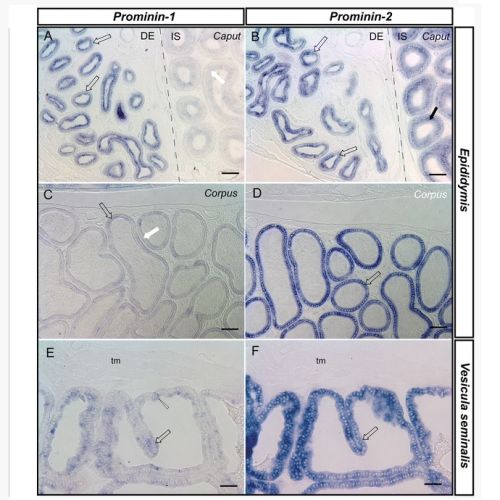Robust expression of Prominin-2 all along the adult male reproductive system and urinary bladder.
Although the male reproductive system seems to be enriched in transcripts encoding for both Prominin genes, little is known about their spatial distribution in distinct segments of this organ system. This is especially true for the less-characterized second Prominin paralogue, Prominin-2. The present study, therefore, mainly examines the expression of Prominin-2 in male mice and reveals the existence of some crucial differences in the tissue compartmentalization of the two Prominin paralogues in the testis, epididymis, seminal vesicle, prostate and urinary bladder. Our in situ hybridization analysis demonstrates that the major domains of overlapping expression between the two Prominin genes are those compartments that are derived ontogenetically from the epigonadal mesonephric tubules, i.e. ductuli efferentes, or from the Wolffian-tube/ductus mesonephricus, for instance the corpus epididymidis and vesicula seminalis. In contrast, the sinus urogenitalis derivative urinary bladder epithelium expresses exclusively Prominin-2, but not Prominin-1 (CD133). The testis expresses only Prominin-1, not Prominin-2. In human prostate, we finally demonstrate that the expression of Prominin-2 (transcript and protein) is highly enriched in cells located in the basal compartment of the glandular epithelium where only a minute population was recently reported to be Prominin-1 positive. Taken together our data indicate that, except for the gonad, Prominin-2 is widely and abundantly expressed along the epithelia of various segments of the adult male genitourinary tract.

- Histochem. Cell Biol. 2008 Oct 07;130(4):749-59
- 2008
- Cell Biology
- 18536929
- PubMed
Enabled by:
